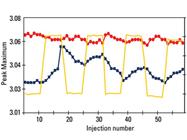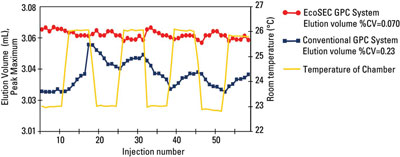Featured Article

Please check out our Gel Permeation Chromatograph / GPC System (GPC SEC) section for more information or to find manufacturers that sell these products.
Overcoming bottlenecks in the laboratory,
and thus saving valuable
time and money, is an important
goal for scientists. This article discusses a
seventh-generation gel permeation chromatography (GPC) instrument that features
improvements in column oven and
pump fluidics, enhancements in temperature
control functions, and high sample
throughput. The all-in-one system rapidly
characterizes polymers with high efficiency,
reliability, and reproducibility. The
system’s performance when used with the
manufacturer’s proprietary multipore GPC
columns is also presented.
One factor that affects GPC analysis is
system reproducibility, as well as systemto-
system variation. Often these variations
are the result of one or more factors,
including flow rate reproducibility, baseline
drift, and injection reproducibility.
For the most part, measurements can be
reproduced using the same equipment, but
may differ when another system is used.
Another important variable is the influence
of temperature fluctuations on solvent
delivery and baseline stability. In the EcoSEC® GPC system (Tosoh Bioscience LLC, Montgomeryville, PA), temperature
control for the pumps, columns, and
tubing has been added. A built-in column
oven, which also houses pump tubing and
columns, ensures that the mobile phase
remains at constant temperature from
injection to the waste vial. This constancy
of temperature is unaffected by changes in
ambient temperature.

Figure 1- Elution time reproducibility of polystyrene standards.

Figure 2- Molecular weight reproducibility of a copolymer
and polyester.

Figure 3- Molecular weight reproducibility of a terpolymer.
Results and discussion
A study was performed to assess
elution time and molecular weight
determination reproducibility using
different polymer samples. The
results (see Figures 1–3) show that
the engineering design concepts of
the system produce highly reproducible
elution times and molecular
mass determinations. The data from
Figure 1 show that the intra- and
interday elution time reproducibility
is <0.03% for the two nearly monodisperse
polystyrene samples. For
poly(vinyl chloride–
vinyl acetate)
and poly(ε-caprolactone), as shown
in Figure 2, intra- and interday Mw
reproducibility, calculated from a
linear polystyrene calibration curve,
were <0.2 and <0.3% CV, respectively.
Reproducibility studies were
also conducted using a terpolymer,
poly(vinyl chloride–vinyl acetate–
vinyl alcohol) (Figure 3). Intra- and
interday data also show reproducibility
values of less than 0.2% in
terms of molecular weight. (The tenfold
increase when going from elution time to
molecular weight is caused by the logarithmic
function of the calibration curve.) These data
exceed results typically obtained from other size
exclusion chromatography (SEC) systems.

Figure 4- Mobile phase delivery reproducibility with ambient temperature changes.
The GPC system also incorporates an extra
cooling fan to remove heat from the pump
heads, a unique check valve design, and better
pressure monitoring to control pump speed.
To assess the environmental influence on solvent
flow, a test was done in which
the EcoSEC GPC instrument and
a conventional GPC system were
placed in a chamber, where the temperature
was cycled. A series of injections
of polystyrene were made over
time. The elution volume at peak
maximum was measured, and the
resulting data are shown in Figure 4.
The elution volume drift of the Eco-
SEC GPC system was approx. 20%
lower than that of the conventional
GPC system. Since the SEC mechanism
is temperature independent, this elution
volume drift was ostensibly caused by expansion
and contraction of the mobile phase, important
considerations especially when using on-line
viscometric detection.

Figure 5 -RI baseline drift comparisons.
With a stagnant, referenced-flow refractive index (RI) detector, the RI of tetrahydrofuran
(THF) mobile phase in the reference cell
slowly alters over time, presumably caused by
the buildup of peroxide-related compounds.
To reduce RI baseline drift, the GPC system
features a second, thermostatically controlled
pump used to pump mobile phase at a controlled
rate through the reference side of the
RI detector. Thus, any minor changes in
mobile phase composition are “zeroed” out,
giving negligible baseline drift. This baseline
stability is demonstrated in Figure 5 using RI
detection and a low-MW test probe, dicyclohexyl
phthalate. With the system, superposition
of five consecutive chromatograms demonstrates
negligible baseline drift (Figure 5a),compared to the same experiment repeatedwith a stagnant reference cell (Figure 5b) from
a conventional GPC unit.

To test instrument reliability, a round-robin
study was undertaken in which the same polydisperse
poly(vinyl chloride–vinyl acetate–
vinyl alcohol) sample was run on EcoSEC
GPC systems located at four different sites.
Each site used the same types of columns
and similar calibration protocol (see Table
1). The sample was run using a TSK-GEL
SuperMultiporeHZ-M column (Tosoh Bioscience
LLC) (4.6 mm i.d. × 15 cm, 4 μm) ×
2 at a flow rate of 0.35 mL/min at 40 °C using
THF as the mobile phase. As shown in the
table, reproducibility from system to system
and from location to location was excellent,
as would be expected from the intralaboratory
studies given in Figures 2 and 3. These results
demonstrate the stable SEC flow rate and
baseline found with the GPC system.
Because of the high instrument-to-
instrument
reproducibility of the system,
methods developed at one location, e.g., an
R&D laboratory, can be transferred to a second
site, e.g., a QC laboratory at a manufacturing
site. The SEC methods can therefore
be reliably duplicated from one site to
another site, which is needed for compliance
with Six Sigma and ISO 9000 certification.
Additional instrument features
The low dead volume of the system and the
low-volume flow cell of the RI result in an
instrument that provides reduced analysis time
and reduced solvent use. The goal of decreasing
solvent consumption and reducing solvent
disposal costs is an operational demand of all
laboratories. By using semimicro technology,
less solvent is used and run times are shortened.
The small stroke volume of the pump
allows for reduced flow rate (10–2000 μL/min)
suitable for ESI-MS of low-MW polymers.
To take advantage of the semimicro design, a
line of GPC columns, the SuperMultiporeHZ
series, was developed. Previously, when
characterizing polymer samples with a widemolecular weight range, scientists were left
with two options: either use columns containing
a mixture of resins with varying pore
sizes or use individual columns packed with
given pore sizes. Here, a different approach
was taken: Through the use of proprietary
multipore technology, particles with widely
varying pore sizes were synthesized.
There are currently three different column
selections in the SuperMultiporeHZ series:
SuperMultiporeHZ-M, -N, and -H, each
with a different particle size, exclusion limit,
and linear MW range. These columns have
a smaller i.d. (4.6 mm) and shorter column
length (15 cm), as compared to most other
commercially available GPC columns. Table 2
details the physical properties of the columns.

Figure 6- Linearity of TSK-GEL SuperMultiporeHZ-M
columns.
Another parameter that affects molecular mass
analysis is the linearity of the SEC calibration
curve. Even columns with the same separation
range can have differently shaped calibration
curves. The SuperMultiporeHZ
columns produce
very good linearity with a shallow slope,
indicative of superior resolution across the
molecular weight range (see Figure 6).
An advantage of using semimicro technology
is that analysis time is 50% lower
compared to conventional columns and
systems, while solvent consumption is
lowered by approximately one-sixth the
volume for a given separation.
The versatility of the EcoSEC GPC system
is realized with the addition of an
optional column-switching valve. The
user is able to conveniently switch from
one column to another of different pore
size and/or column length for optimal
molecular mass separation. Furthermore,
an empty capillary tube can be inserted
in place of the second column for sample
recovery studies. This approach can be
used to determine whether or not complete
elution of the sample has occurred without
irreversible adsorption, a potential source of
error occasionally encountered.
The system is controlled by EcoSEC GPC
Work Station software, which is capable
of running two instruments. This powerful,
versatile software is intended to facilitate
and simplify system operation and data
analysis. Setting authentication, passwords,
and user access privileges is effortless. The
software manages the instrument, allows
programming start and shutdown times,
displays operating conditions in real time,
audits the data, and prints custom reports.
To aid in SEC calibration, PStQuick calibration
standard kits (Tosoh Bioscience)
are available in a wide range of molecular
weights. The kits are premixed polymer
standards to facilitate column calibration.
The calibration standards help give highly
reproducible calibration curves, which are
essential for reliable molecular mass analysis.
In addition, calibration of a TSK-GEL
SuperMultiporeHZ column with PStQuick
standards can be completed in a few hours
rather than the day or more that is required
with conventional columns and standards.
Conclusion
Using TSK-GEL SuperMultiporeHZ
series semimicro columns and PStQuick
standards, the EcoSEC GPC system
reduces solvent cost, increases throughput,
and minimizes errors in setting up
calibration standards. The instrument
has been specifically designed for routine
or standardized SEC analysis, where
a premium is placed on high-precision
molecular mass measurements.
Please check out our Gel Permeation Chromatograph / GPC System (GPC SEC) section for more information or to find manufacturers that sell these products.
Dr. Villarreal is GPC Marketing Manager,
Tosoh Bioscience LLC, 156 Keystone Dr.,
Montgomeryville, PA 18936, U.S.A.; tel.: 215-
283-5028; e-mail: [email protected]. Dr. Barth is a consultant specializing in the application
of size-exclusion chromatography(e-mail: [email protected]).